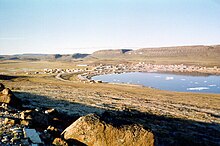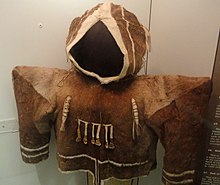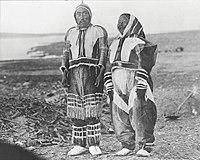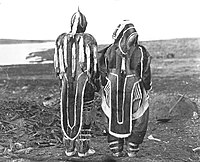Copper Inuit
| Total population | |
|---|---|
| 800[1] | |
| Regions with significant populations | |
| Northwest Territories; Nunavut | |
| Languages | |
| Inuvialuktun(sometimes called Western Canadian Inuktitut; also referred to asInuinnaqtun) | |
| Religion | |
| Animism;Inuit religion |
| Inu- ᐃᓄ- / nuna ᓄᓇ "person" / "land" | |
|---|---|
| Person | Inuinnaq |
| People | Inuinnait |
| Language | Inuinnaqtun; Tikuraq ᑎᑯᕋᖅ |
| Country | Inuinnait Nunangat, Inuit Nunangat ᐃᓄᐃᑦ ᓄᓇᖓᑦ |

Copper Inuit,also known asInuinnait[2]andKitlinermiut,[3][pronunciation?]are a CanadianInuitgroup who live north of thetree line,in what is now theKitikmeot RegionofNunavutand in theInuvialuit Settlement Regionin theInuvik Regionof theNorthwest Territories.Most of them historically lived in the area aroundCoronation Gulf,onVictoria Island,and southernBanks Island.
Their western boundary was Wise Point, nearDolphin and Union Strait.Their northwest territory was the southeast coast of Banks Island. Their southern boundary was the eastern shore ofGreat Bear Lake,Contwoyto LakeandLake Beecheyon theBack River.To the east, the Copper Inuit and theNetsilingmiutwere separated byPerry RiverinQueen Maud Gulf.While Copper Inuit travelled throughout Victoria Island, to the west, they concentrated south ofWalker Bay,while to the east, they were concentrated south ofDenmark Bay.[4]
As the people have no collective name for themselves, they have adopted the English term "Copper Inuit".[5]It represents those westernmostCentral Inuitwho used and relied onnative coppergathered along the lowerCoppermine Riverand the Coronation Gulf.[6]
According toKnud Rasmussen(1932), other Inuit referred to Copper Inuit asKitlinermiut,asKitlineqwas anInuit languagename for Victoria Island.[7]
History[edit]
Early millennia[edit]
Copper Inuit, like all Inuit, are descendants of theThule people.Changes in the environment may have resulted in the transition from prehistoric Thule culture to CopperInuit culture.[4]
For about 3,000 years[8]the Copper Inuit werehunter-gatherernomads.Their settlement and acculturation to some European-Canadian ways has occurred only since the 1940s, and they have also continued the hunting and gathering lifestyle.[9]
They lived in communalsnowhousesduring the winter and engaged in breathing-hole (mauliqtoq) seal hunting. In the summer, they spread out in smaller, family groups for inlandcaribouhunting and fishing.[1]
The people made copper arrows, spear heads,ulublades, chisels, harpoons, and knives for both personal use and for trade amongst other Inuit. In addition to the copper products, Copper Inuitsoapstoneproducts were highly regarded in theBering Straittrade network.[10]Other trade partners includedInuvialuitfrom theAvvaq PeninsulaandCaribou Inuitto the south.[11]Many Copper Inuit gathered in theCambridge Bayarea in the summertime because of plentiful game.[12]
Post-Euro-Canadian contact[edit]
According toRobin McGrath,there are Inuit stories that show there was a history of conflict between the Inuit and theDene,as well as others which may have involved Europeans. This conflict seems to have been instigated by both the Dene and the Inuit and possibly was caused by trade disputes but sometimes due to raids for women.[13]One of the better known of these battles was recorded by European explorer,Samuel Hearne.In 1771, Samuel Hearne was the first European to explore the Coppermine River region. It was here thatMatonabbee,leader of Hearne'sChipewyanDene guides, and his companionsmassacred a Copper Inuitgroup atBloody Falls.[1]Further exploration did not take place until the period of 1820–1853, which included the SirJohn Franklinexpeditions of 1821 and 1825.John Raeencountered Copper Inuit atRae Riverin 1847, and atCape FlindersandStromness Bayin 1851.[14]During theMcClure Arctic expedition,Irish explorer,Robert McClureabandoned his ship,HMSInvestigator,atMercy Bayon Banks Island in 1853 during his search forFranklin's lost expedition.It provided extensive amounts of wood, copper, and iron which the Copper Inuit used for years.Richard Collinsonexplored the area in 1850–1855.
20th century[edit]
In the belief that the Copper Inuit had migrated toHudson Bayfor trading at various outposts, the Canadian government's 1906 map marked Victoria Island as "uninhabited".[1]It was not until the early years of the 20th century that trading ships returned to Copper Inuit territory. They followedVilhjalmur Stefansson's encounter with, and report on, so-calledBlond Eskimosamong the Copper Inuit[15]from hisArctic explorationof 1908–1912.[16][17]During theCanadian Arctic Expedition, 1913–1916,Canadian ethnographerDiamond Jennessspent two years living with and documenting the lives of Copper Inuit. He sent thousands of artifacts of their material culture to theGeological Survey of Canada.[18]
Along with trade, European contact broughtinfluenzaandtyphoid.These newly introduced infectious diseases likely weakened resistance of the natives. Between 1929 and 1931, one in five Copper Inuit died from atuberculosisepidemic. Around the same time, thewhalingindustry deteriorated. AlaskanIñupiatandMackenzie DeltaInuvialuit came into the Coronation Gulf area to co-exist with the Copper Inuit.[11]The firstHolman-area (Ulukhaktok)trading postwas established in 1923 at Alaervik, on the north shore ofPrince Albert Sound,but it closed five years later. The post relocated toFort Collinsonon Walker Bay, north ofMinto Inlet.Two other stores opened in Walker Bay but closed by 1939, in the years of theGreat Depression.
Settlement[edit]
In 1960, the federal government shipped threehousing unitsto Holman, and another four in 1961. In the years to follow, some families moved to Holman permanently, while others lived there seasonally. Some Copper Inuit moved to the communities ofCoppermine(Kugluktuk) or Cambridge Bay. Still others gravitated to outposts alongBathurst Inlet,Contwoyto Lake,Coronation Gulf,and on Victoria Island.[19]
The Copper Inuit have gradually adoptedsnowmobiles,satellite dishtelevision service, and Christian churches. Many young people now speak English rather thanInuinnaqtun.Together, these introductions have created social change among the Copper Inuit.[1]
Culture[edit]
Language[edit]
Copper Inuit traditionally speak Inuinnaqtun[20]andInuvialuktun,sometimes referred to as Western Canadian Inuktitut.[21]
Habitat and diet[edit]
Historically, Copper Inuit lived amongtundra,rocky hills, outcrops, with some forested areas towards the southern and southwestern range. Here they huntedArctic ground squirrel,Arctic hare,caribou (barren groundandPeary'sherds),grizzly bear,mink,moose,muskox,muskrat,polar bear,wolf,andwolverine.They fished in the extensive network of ponds, lakes, and rivers, including the Coppermine, Rae, andRichardson Rivers,which sustained large populations of freshwaterArctic char(also found in the ocean),grayling,lake trout,andwhitefish.The marine waters supportedcodfish,bearded seal,andringed seal.[19]Ducks, geese, guillemots, gulls, hawks, longspurs, loons, plovers, ptarmigans, and snow buntings were also part of the Copper Inuit diet. They liked raw but not boiledeggs.[22]They used and cooked food and products from the sea, but kept them separate from those of the land.[23]
Clothing[edit]

CopperInuit clothingconsisted of short-waisted innerparkasaccented with long, narrow back tails, and sleeves that came short of the wrist. In severe weather, they added a heavy outer parka. Women's parkas were distinguished by elongated hoods, and exaggerated, pointed shoulders. Boots extended up the leg to button at the waistline. They made the soles from feathers or bird skins.[19]Copper Inuit used different napkins for different meals: ptarmigan skins when eating caribou, and gull skins when eating seal.[22]
Contemporary clothing and boots may be made of a variety of skins, including:[19]
- Dance cap: caribou, ermine, and thebillof ayellow-billed loon[22]
- Parkas: Arctic hare, otter, rabbit, wild mink
- Mitts: beaver, polar bear, skunk
- Boots: caribou, dog, polar bear, seal, wolf, wolverine
- Kamiit:caribou, moose
In addition to their everyday clothing, historically, many Inuit had a set of ceremonial clothing made of short-haired summer skins, worn for dancing or other ceremonial occasions. In particular, the dance clothing of the Copper Inuit has been extensively studied and preserved in museums worldwide.[24]The design of these garments was inextricably linked with thereligious practicesof the Copper Inuit, containing what anthropologistBernadette Driscoll-Engelstaddescribes as "design references alluding to the integration of the human and animal realm, the natural and the supernatural."[25]By the 1930s, the ceremonial clothing of the Copper Inuit had died out, although it was intentionally revived in the 1990s.[24]
Religion[edit]
Copper Inuit had ananimisticspiritual system,[23]which included belief that animal spirits could be offended throughtabooviolations.[5]They believed that dwarfs, giants, "caribou people", and the sea-goddessArnapkapfaalukor "big bad woman" inhabit the world.[5]Their conception of thetupilaqis similar to theChristianconcept of thedevil.[26]
Theangakkuit(shamans) could be male or female. They warded off evil spirits, functioned as intermediaries between people and the spirit world, healed illness or taboo violations, and controlled weather.[5]
Subgroups[edit]
Copper Inuit lived within geographically defined subgroups well documented by Stefansson,[27][28]Franz Boas,and others:
- Ahiagmiut:Ogden Bay
- Akuliakattagmiut:Cape Bexley
- Asiagmiut:Ogden Bay
- Ekalluktogmiut:Ekalluk River,Albert Edward Bay;centralVictoria Island
- Haneragmiut:Dolphin and Union Strait
- Haningayogmiut:Back River
- Kaernermiut:Back River
- Kangiryuarmiut:Prince Albert Sound,Cape Baring,central Victoria island;Nelson HeadonBanks Island
- Kangiryuatjagmiut:Minto Inlet;between Minto inlet andWalker Bay
- Kilusiktogmiut:Victoria Island;Coronation Gulfarea at the mouth of theMackenzie River[28]
- Kogluktogmiut:Bloody Fallson theCoppermine River,Dease River,andGreat Bear Lake(McTavish Bay); Coronation Gulf, southeast ofCape Krusenstern
- Kogluktualugmiut(orUtkusiksaligmiut– "the dwellers of the place where there is pot stone" ):Tree River( "Kogluktualuk" ), 130 km (80 mi) east of the Coppermine River[27]
- Kogluktuaryumiut:from the mouth of theKogluktuaryuk River[27]which flows intoGrays Bayon up river; Grays Bay and the Coronation Gulf ice off of it[28]
- Kugaryuagmiut:Kugaryuak River[27]
- Nagyuktogmiut(orKillinermiut):Nagyuktok Island,one of theDuke of York Islands;[27]central Coronation Gulf; Victoria Island northeast ofLady Franklin Point;mainland east of Tree River;Dismal Lakesnear the head of Dease River;[28]( "Deer Horn Esquimaux" )
- Noahonirmiut(orNoahdnirmiut): Liston andSutton Islandsin the Dolphin and Union Strait to the mainland: north ofRae River,south of Lambert Island[27][28]
- Pallirmiut:mouth of the Rae River (Pallirk) and head of Dease River; Coronation Gulf, southeast of Cape Krusenstern[27][28]
- Pingangnaktogmiut:Pingangnaktok ( "it blows a land wind" ), inland west of Tree River[27]
- Puiplirmiut(orPuiblirmiut): Dolphin and Union Strait near Liston and Sutton Islands; also north and northeast of Simpson Bay on Victoria Island[27][28]
- Ugyuligmiut:north of Minto Inlet[27]
- Ulukhaktokmiut:Ulukhaktok(formerly known as Holman), after the copper used inulumaking that was found there[5]
- Umingmuktogmiut:permanent village ofUmingmaktok(Umingmuktog) on the western coast ofKent Peninsula;[27]Bathurst Inlet[28]
Notable Copper Inuit[edit]
- Joe Allen Evyagotailak
- Donald Havioyak
- Helen Kalvak
- Helen Maksagak
- Kane Tologanak
- Uloqsaq(historical)
References[edit]
- ^abcdeCondon, Richard G.(1987).Inuit Youth: Growth and Change in the Canadian Arctic.Rutgers University Press. pp. 25–38.ISBN978-0-8135-1212-9.Also seeInuit Youth,p. 25, atGoogle Books
- ^McGhee, Robert (4 March 2015)."Inuinnait (Copper Inuit)".The Canadian Encyclopedia.Historica Canada.
- ^Robinson, Michael (3 March 2018)."The myth of a 'lost white tribe'".Boston Globe.
- ^abVanStone, James W.(1994).The Noice Collection of Copper Inuit Material Culture.FieldianaAnthropology. Vol. 22. Field Museum of Natural History.
- ^abcde"The Copper Inuit (Ulukhaktokmiut) of Holman".The Ohio State University. 26 November 2007.Retrieved24 August2008.
- ^Gordon, Bryan."Copper Inuit".Nadlok and the Origins of the Copper Inuit.Canadian Museum of History.Archivedfrom the original on 29 October 2004.Retrieved22 August2008.
- ^Martin, Marlene M."Society-COPPER-ESKIMO".lucy.ukc.ac.uk. Archived fromthe originalon 14 May 2008.Retrieved25 August2008.
- ^Fleming, Stuart J.; Schenck, Helen R. (1989).History of Technology: The Role of Metals.UPenn Museum of Archaeology. p. 68.ISBN978-0-924171-95-6.
- ^Davis, Jonathan Duffy; Banack, Sandra Anne (December 2012)."Ethnobotany of the Kiluhikturmiut Inuinnait of Kugluktuk, Nunavut, Canada".Ethnobiology Letters.3:78–90.doi:10.14237/ebl.3.2012.31.JSTOR26423547.
- ^Morrison, David (1 January 1991)."The Copper Inuit Soapstone Trade"(PDF).Arctic.44(3).doi:10.14430/ARCTIC1544.ISSN0004-0843.JSTOR40511245.WikidataQ60205412.
- ^abIssenman, Betty Kobayashi (2011).Sinews of Survival: The Living Legacy of Inuit Clothing.UBC Press. p. 110.ISBN978-0-7748-4189-4.
- ^"About Cambridge Bay".BuildingNunavut.com.Government of Nunavut.Archivedfrom the original on 13 January 2010.Retrieved21 July2021.
- ^McGrath, Robin (6 June 1993)."Samuel Hearne and the Inuit Oral Tradition".Studies in Canadian Literature.18(2).
- ^Bunyan, Ian (1993).No Ordinary Journey: John Rae, Arctic Explorer, 1813–1893.McGill-Queen's University Press. pp. 100–101.ISBN978-0-7735-1107-1.
- ^Pálsson, Gísli (2007).Anthropology and the New Genetics.Cambridge University Press. pp. 191, 200.ISBN978-0-521-85572-3.
- ^"History:, The Canadian Arctic Expedition (1913-1918)".Beaufort Gyre Exploration Project.Woods Hole Oceanographic Institution.Retrieved21 September2008.
- ^Francis, Daniel (1986).Discovery of the North: The Exploration of Canada's Arctic.McClelland & Stewart. pp. 205–208.ISBN978-0-88830-280-9.
- ^von Finkelstein, Maria."Diamond Jenness (1886–1969)".Playthings and curios: historic Inuit art.Canadian Museum of History.Retrieved21 July2021.
- ^abcd"Clothing, footwear and territory of the Caribou Inuit".AAANativeArts.com.Retrieved21 July2021.
- ^Wurm, Stephen A.; Mühlhäusler, Peter; Tryon, Darrell T., eds. (1996).Atlas of Languages of Intercultural Communication in the Pacific, Asia, and the Americas.Vol. II: Texts. Walter de Gruyter. pp. 1059–1060.ISBN978-3-11-081972-4.
- ^InuinnaqtunatEthnologue(24th ed., 2021)

- ^abcKing, J.C.H.; Paukstatz, Birgit; Storrie, Robert, eds. (2005).Arctic Clothing of North America – Alaska, Canada, Greenland.McGill-Queen's University Press. pp. 63–68.ISBN978-0-7735-3008-9.
- ^abEdgecombe, Nancy A. (2001). "Appendix: Value Orientations of the Copper Inuit". In Pamela J. Brink; Marilyn J. Wood (eds.).Basic Steps in Planning Nursing Research: From Question to Proposal.Boston: Jones & Bartlett Publishers.ISBN978-0-7637-1571-7.
- ^abDriscoll-Engelstad, Bernadette (1 January 2005)."Dance of the Loon: Symbolism and Continuity in Copper Inuit Ceremonial Clothing".Arctic Anthropology.42(1): 33–46.doi:10.1353/arc.2011.0010.ISSN0066-6939.JSTOR40316636.S2CID162200500.
- ^Driscoll-Engelstad (2005),p. 34.
- ^Ohokak, G.; Kadlun, M.; Harnum, B.Inuinnaqtun-English Dictionary(PDF).Kitikmeot Heritage Society.
- ^abcdefghijkStefánsson, Vilhjálmur(1914).The Stefánsson-Anderson Arctic Expedition of the American Museum: Preliminary Ethnological Report.Anthropologic Papers. Vol. XIV, Part I. New York: The Trustees of the American Museum of Natural History. pp. 26–31.
- ^abcdefghStefánsson, Vilhjálmur (30 December 1914)."Prehistoric and present commerce among the Arctic coast Eskimo".Canada Geological Survey Museum Bulletin.Anthropologic Series no. 3. No. 6. Ottawa: Government Printing Bureau.doi:10.5962/bhl.title.27623.
Further reading[edit]
- Condon, Richard G.; Julia Ogina (2006).The northern Copper Inuit: a history.University of Toronto Press.ISBN978-0-8020-0849-7.
External links[edit]
- The Copper Inuit,Foragers
- Photos
- Kitikmeot Place Name Atlas– includes the spoken Inuinnaqtun version of some places in this article
- The 5th Thule AtlasCopper Inuit Culture Area


